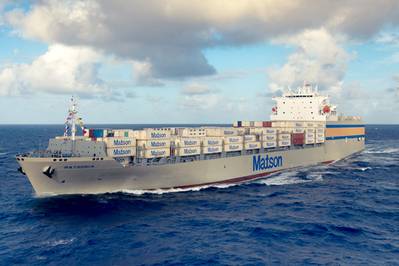Matson Targets Net Zero GHG Emissions by 2050
U.S.-based Matson, a carrier in the Pacific, said this week it will reduce its fleet greenhouse gas (GHG) emissions by 40% by 2030, and achieve net zero fleet GHG emissions by 2050.
The Honolulu-headquartered company joins peers such as Denmark-based Maersk and Switzerland-based MSC on a growing list of international shipping companies to reveal decarbonization plans that go beyond the International Maritime Organization's (IMO) target to reduce overall GHG emissions from ships by 50% from 2008 levels by 2050.
Shipping, which transports some 90% of world trade, produces nearly 3% of the world's CO2 emissions, and the sector is facing increased pressure to become cleaner.
"We are committed to doing our part in helping the world decarbonize and limit climate change," said Matt Cox, Matson chairman and chief executive officer. "We believe we have a responsibility to significantly reduce our carbon footprint by lowering our greenhouse gas emissions and our aim is to achieve these medium- and long-term goals by improving fleet and operational efficiency.
"Matson is supporting efforts to create an industry-funded research and development program to accelerate zero-carbon fuels and technologies. While these transformative technologies develop, we will continue to focus on improving the efficiency of our fleet and terminal operations."
To help limit fuel consumption, Matson—having already slashed its fleet GHG emissions by 23% since 2016—said it is evaluating and planning to pursue a number approaches to further increase efficiency, including reducing vessel speeds, cold ironing, anti-fouling or friction-reducing hull coatings, new engine monitoring technology and upgraded vessel weather routing services.
The company, which recently completed a more than $900 million Hawaii fleet renewal, said it is also exploring liquefied natural gas (LNG) and cleaner-burning future fuels, while implementing more environmentally sensitive container design practices and refrigerants, and designing new vessels to be energy efficient, with features such as shaft generators and improved bulbous bow, hull, rudder and propeller designs.

















